Norway is a paradise for outdoorsy people. Norwegian universities even offer a course in outdoor life. With unspoiled nature and pristine landscapes, Norway has everything to turn your cycling holiday into an adventure of a lifetime. If you plan a bicycle tour in Norway, you’re in the right place. As a person who lived in Norway and travelled there by bike, I share my tips to help you prepare for your bicycle tour in the country of trolls and fjords.
In normal countries, there is some balance: pretty landscapes, ugly industrial zones, some pretty landscapes again, and more ugliness again. But not in Norway.
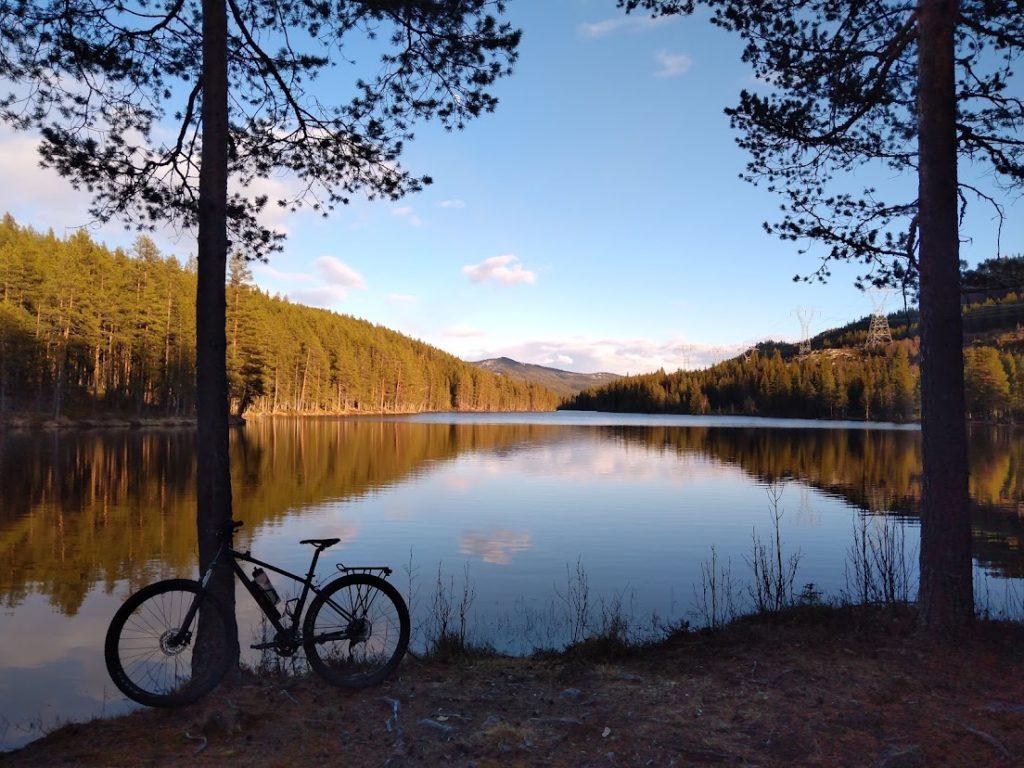
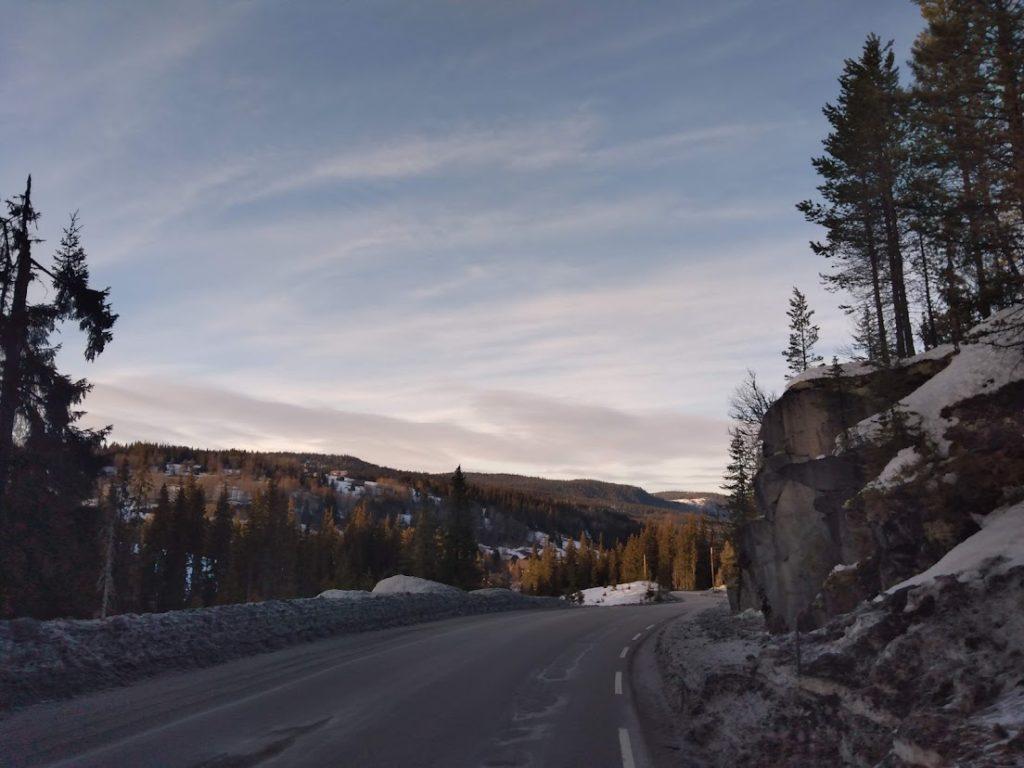
Behind every turn are monstrous mountain ranges, cobalt fjords, green forests, or cold lakes. Rocks, water and conifers. Is there a better setting for bicycle touring than that?
Brace yourself for long, depleting climbs and cold and wet, and get the highest reward: long descents, unspoiled campsites, and astonishing views.
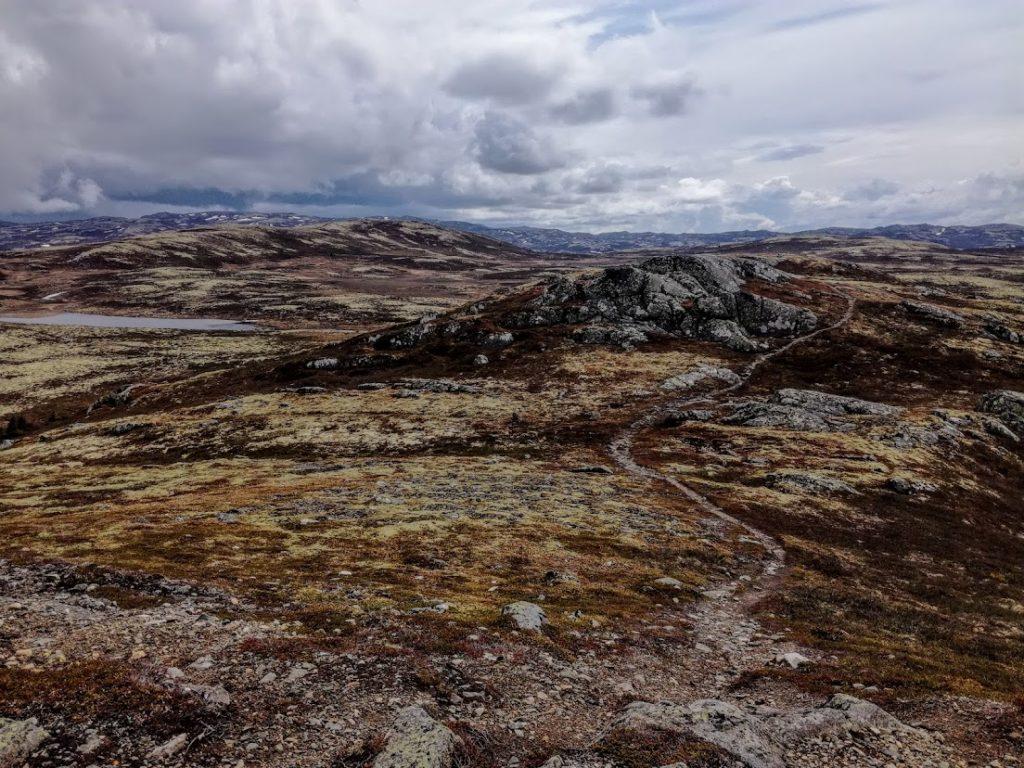
How to get there
Plane
Norway is the European country with the most plane connections per capita. It is well connected with all major European cities. Most flights operate to the main airport in the country, Oslo Gardemoen.
Fly directly to Tromsø if you want to experience the vastness of the Arctic Circles (direct flights from Germany, Finland, Sweden and the UK). For cycling the scenic Trollstigen, arriving in Ålesund (direct flights from Alicante, Amsterdam, Gdansk, Kaunas and Copenhagen) is best.
Ferry
If you rather skip packing your bike on a plane, consider taking a ferry. You can take a boat to Norway from Denmark, Germany and Sweden. For more information, check colorline.com, dfds.com or fjordline.com
Bike rental
You can rent a bike in Norway if you don’t want to take your own. Some airports even offer Fly and bike – a chance to pick up your rental bike directly at the airport (like a rental car). It’s often possible to rent panniers as well.
The prices depend on the city and the length of the rental, from 300 NOK/day to 700 NOK/day. Sometimes, returning to a different location is possible. You can find more information here.
Terrain
Norway is mountainous, so make sure your legs can handle long and steep climbs before coming here with your bike. Inland and in the northern parts and inland, there are long stretches between towns. Ensure you carry enough food, as finding a shop for many kilometres might be problematic.
Roads and traffic
Norway’s roads are well maintained and in good condition, although sometimes narrow. Luckily, there is usually little traffic, and drivers are rather considerate. But watch out for electric cars: I got scared by them being right behind me a couple of times as I didn’t hear the engine on an otherwise empty road. Don’t let them lull you.
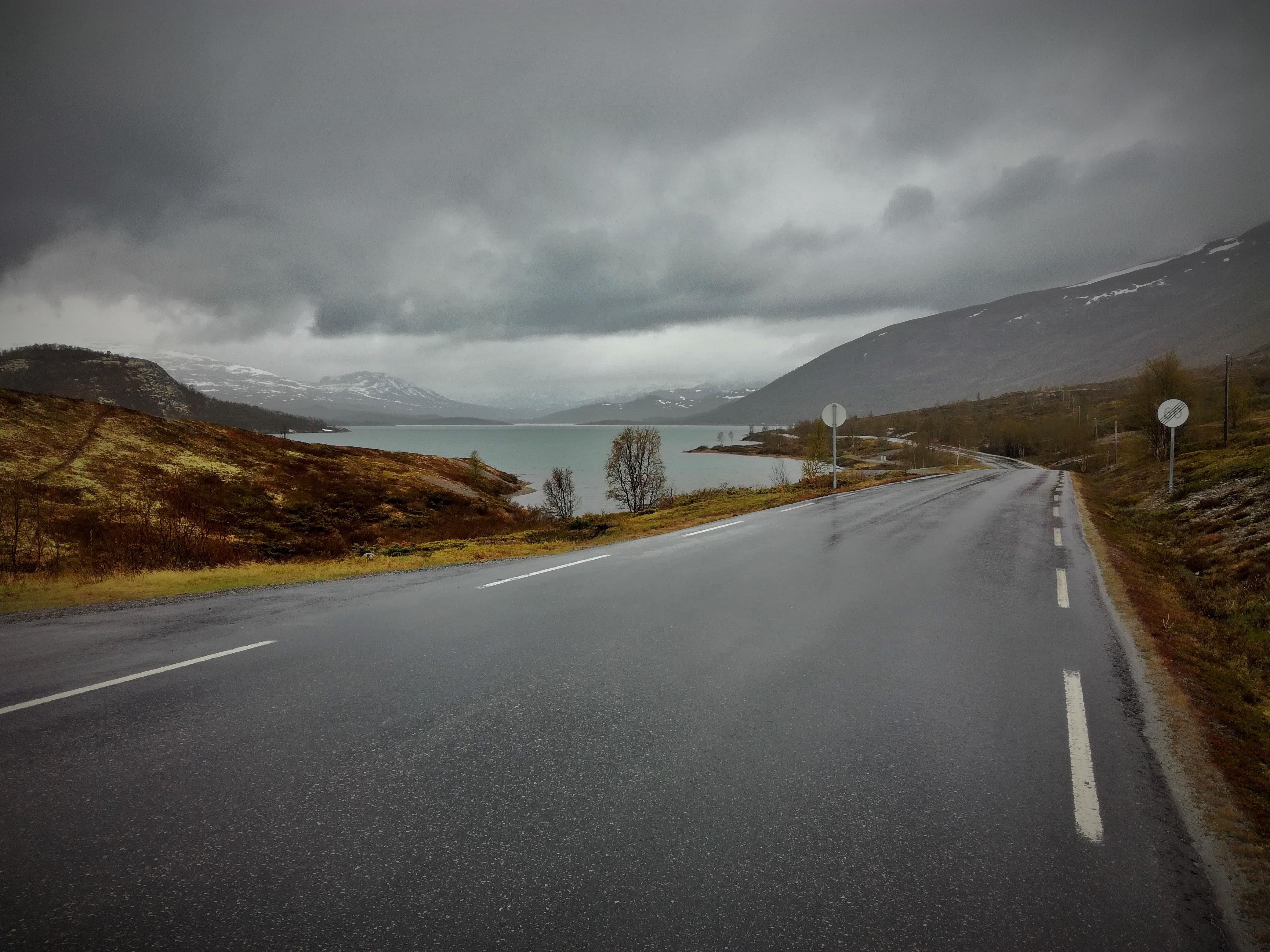
Norway has a few long-distance cycling routes, but most are on motorised roads, and there are not many bicycle lanes.
Mountain roads such as Trollstigen and Valdresflya are only open a few months of the year. You can find more information about it here and here.
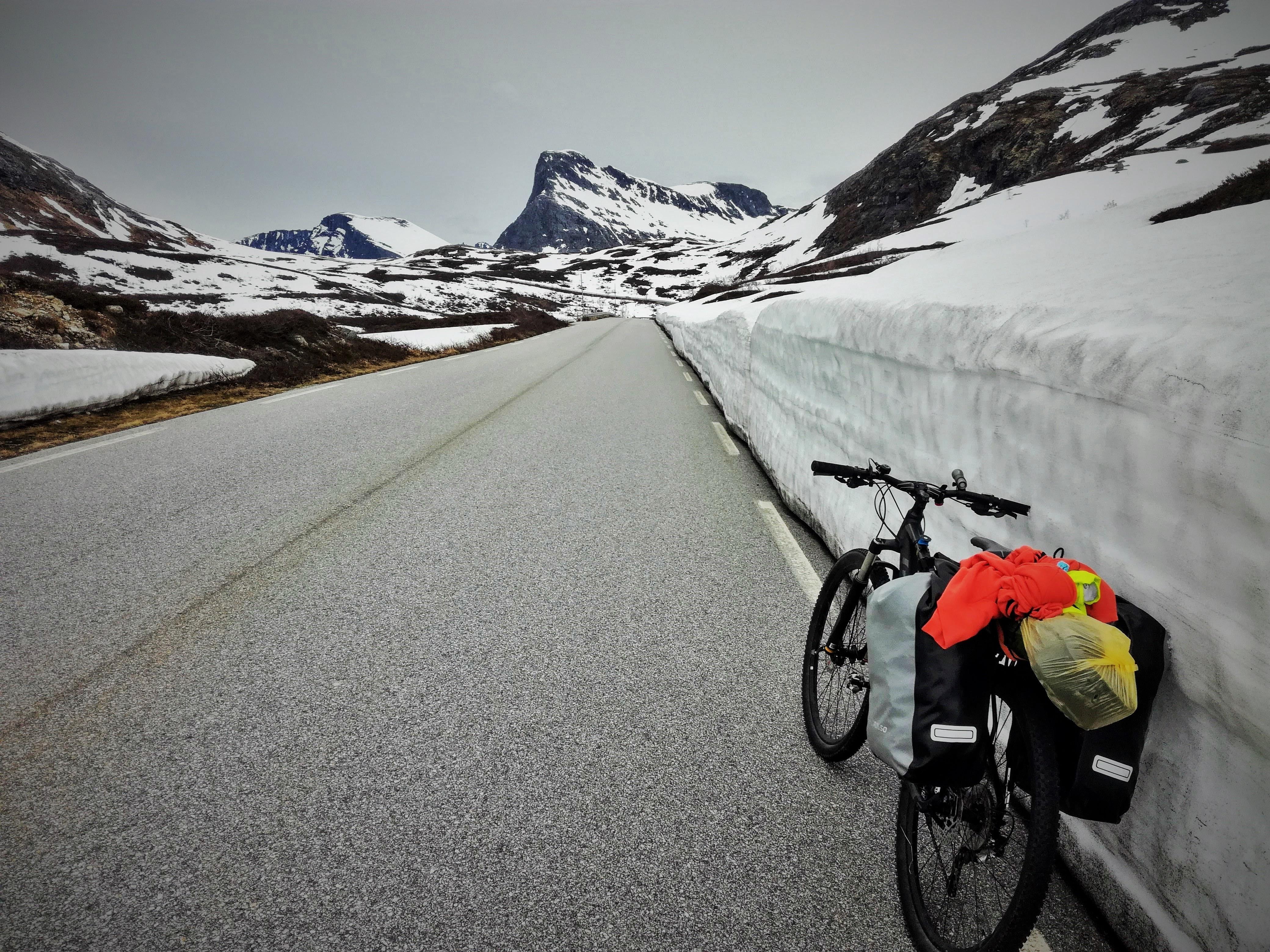
Tunnels
Norway has more than 1200 tunnels, with the world’s longest Lærdal tunnel (24,5 km long). Not all of them are open or safe for bicycles. You should always plan your route carefully, and if you see a tunnel on a map, check this website to see if you can cross it by bike. Some of them are really steep, so check if you can get into one before blocking it, like this Turkish cyclist under the Oslo Fjord.
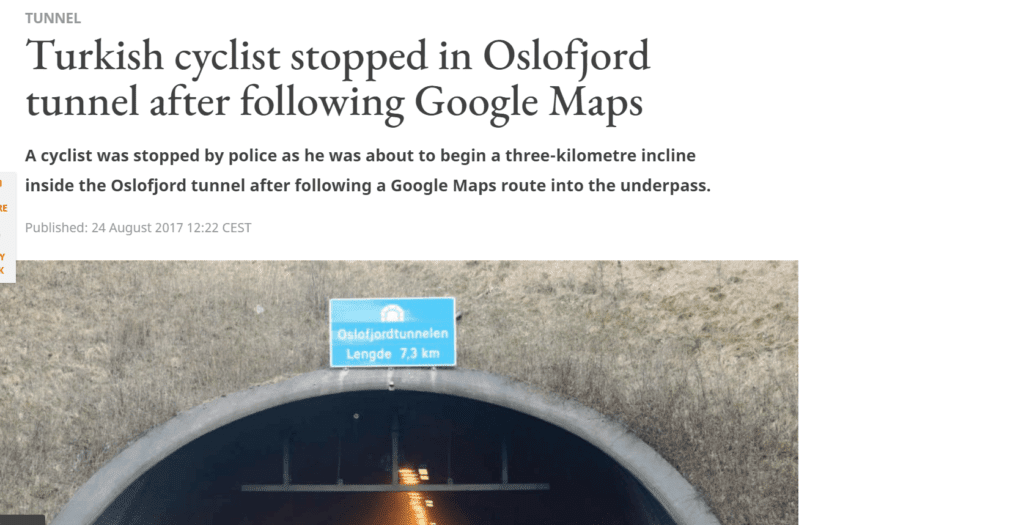
Ferries
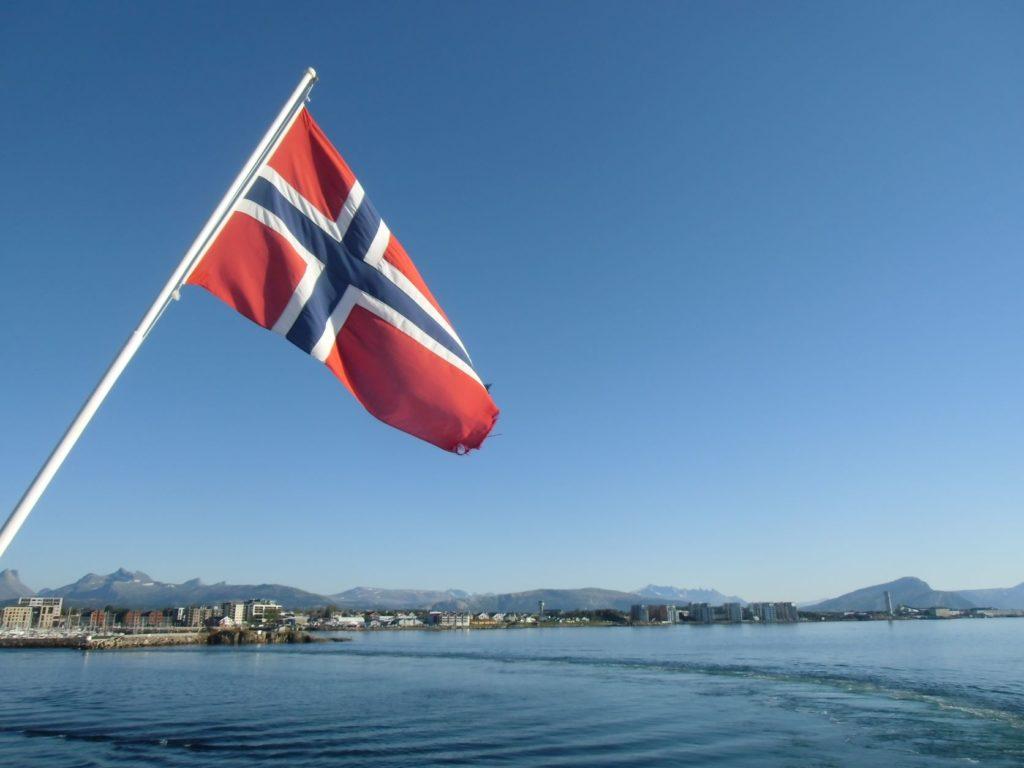
Cycling through Norway, you will likely need to take a ferry to avoid massive detours around the fjords. Since the ferries in the districts are run by different operators, finding information about timetables and prices might be challenging. Here are some links that can be helpful in various regions:
- Møre og Romsdal, check this website.
- North Trøndelag, check this website.
- Oslo and Akershus, check this website.
- Nordland, check this website.
- Troms, check this website.
The ferry on the Horten-Moss route through the Oslo Fjord is free for pedestrians and cyclists. Departures are every half hour, every 15 minutes during rush hour. You can find the timetable here.
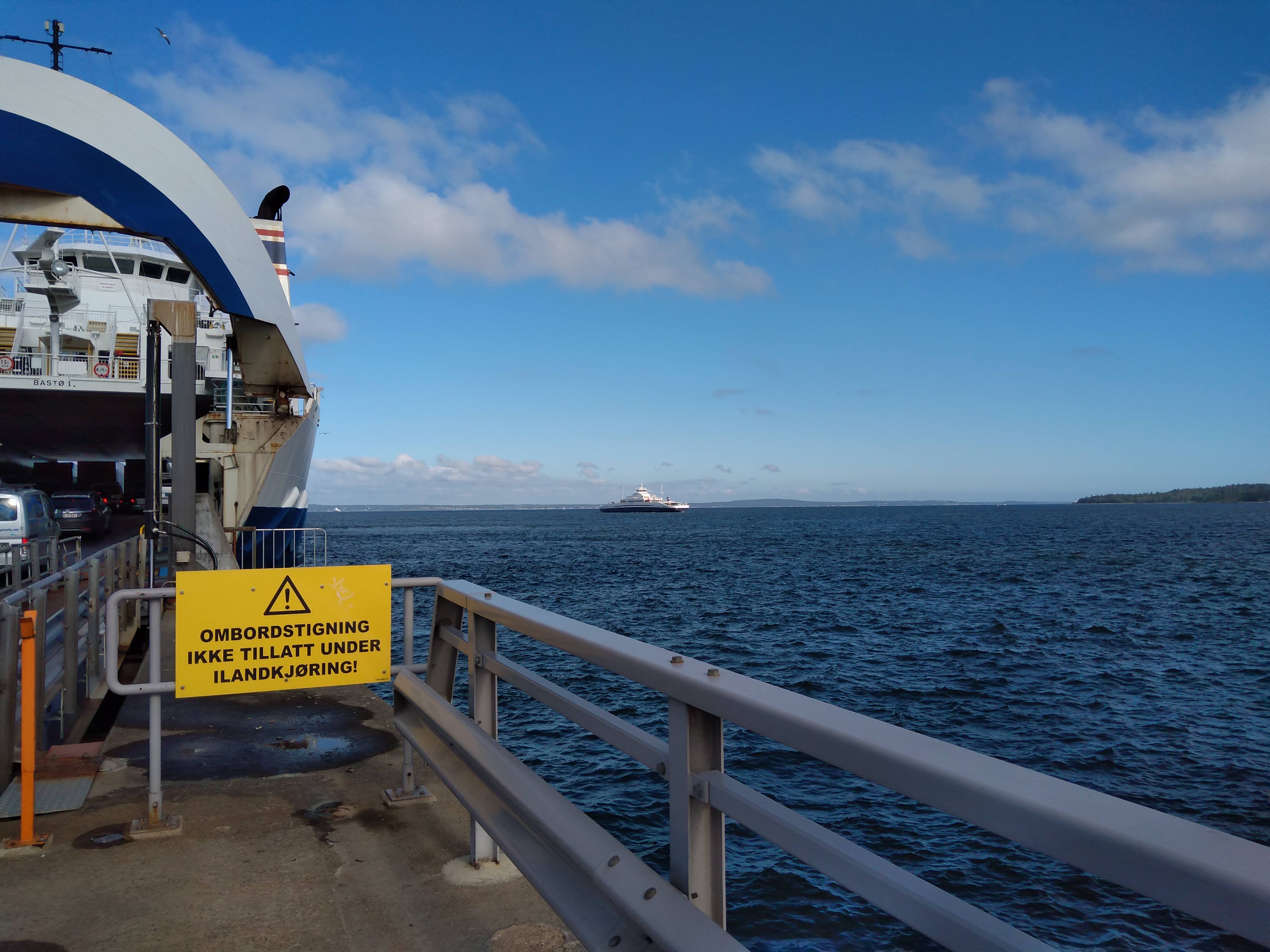
Trains
Norway is vast, and sometimes, you might want to cheat and take your bike on a train. If you plan to travel by train, book tickets in advance to secure the cheapest tickets.
The price of a bicycle ticket depends on the route. For a given distance, it is equal to the price of a child ticket.
You can find all the information about taking your bike on a train in Norway here.
The railway network is concentrated in the south of the country. Once you reach Trondheim, only one line goes further north, to Bodø, and only twice a day.
Weather
The best time to visit Norway with your bike is summer, late spring and early autumn. If you come too early in spring, you risk that there will still be snow in the higher parts of the mountains, and some mountain roads might still be closed.
If you are a hardcore person who loves cycling in the snow, go ahead. Make sure you have studded tyres and good winter gear. Remember that days are extra short in winter, and the sun doesn’t even bother to show up beyond the Arctic Circle.
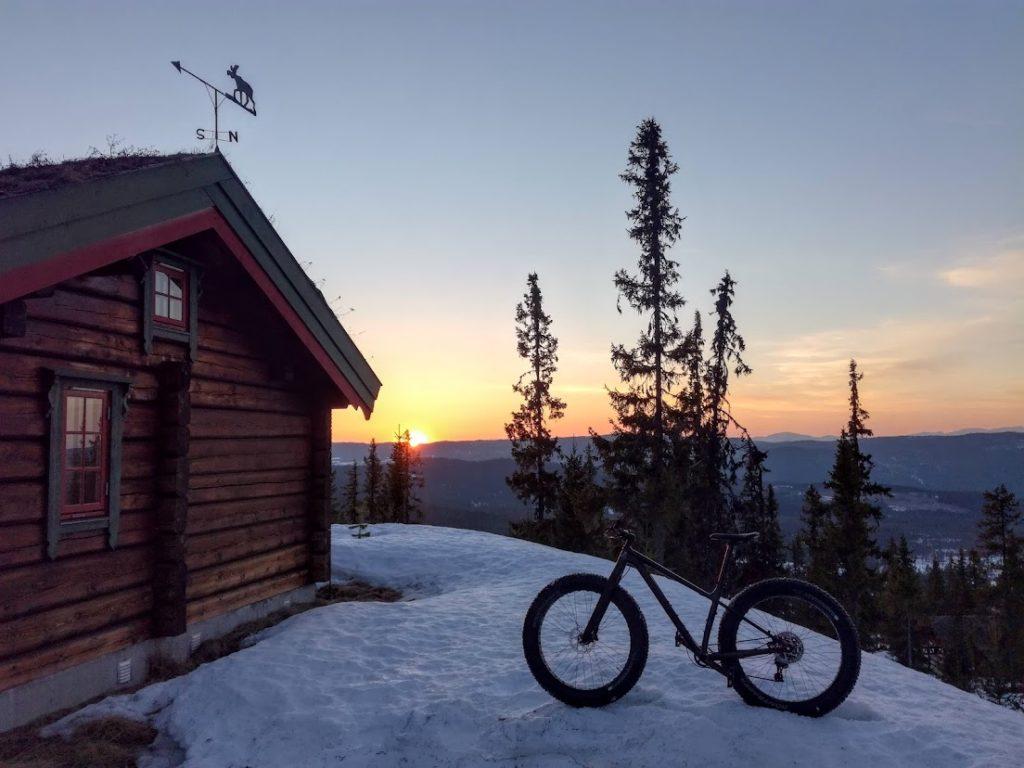
If you visit Norway in summer, you will, on the contrary, be able to enjoy long days. It is a bizarre experience to set up your tent around midnight and not even have to reach out for a headlamp.
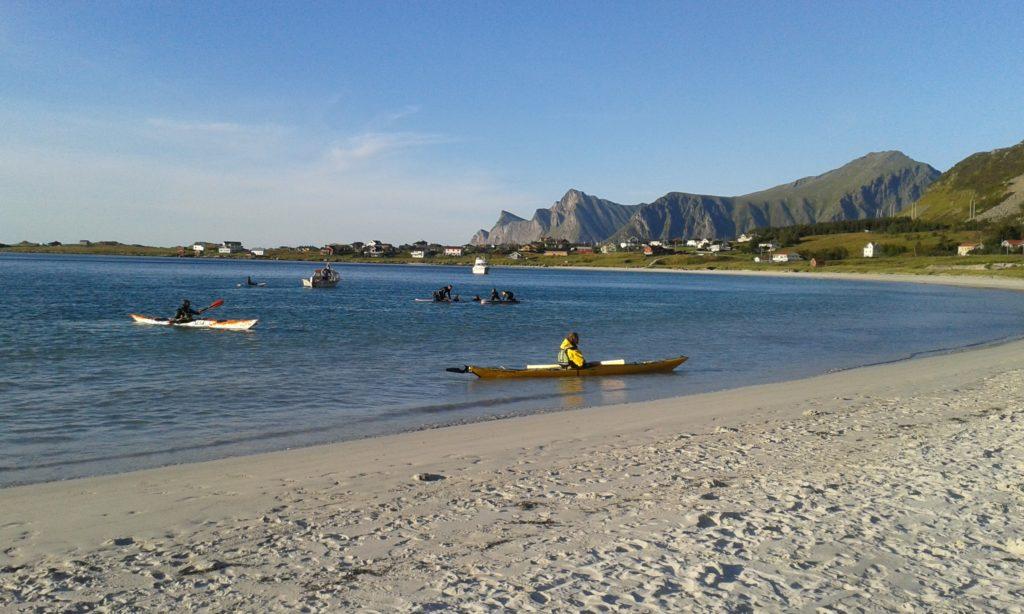
In the mountains, you can expect some snow even in summer. The conditions can change rapidly. Always check the weather reports on yr.no before embarking on a trip.
Must have for cycling in Norway
- A reflective vest and good lights can save your life in countless Norwegian tunnels. They might also improve your safety in the fog and rain. When cycling through Valdresflya early in June 2019, I ended up in soupy conditions with about 10 meters of visibility. I could barely see the lights of cars coming from the other directions, and there was no side emergency lane (or, if there was one, it was covered with snow).
- Good rain jacket and waterproof pants.
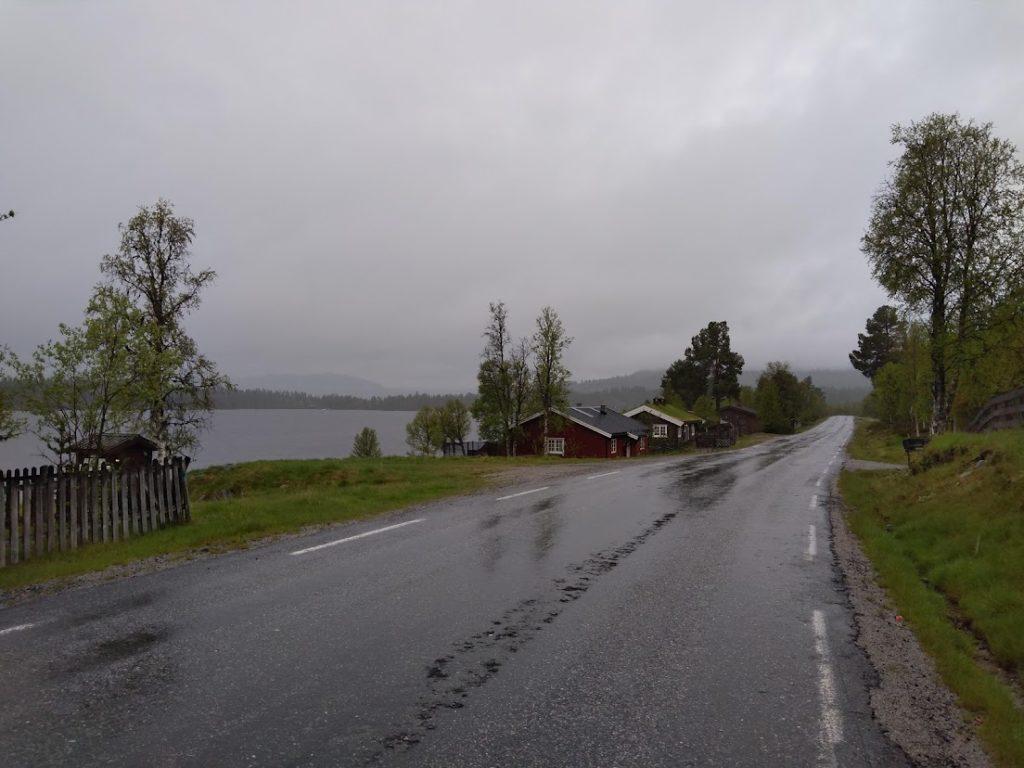
- Warm clothes, even in the summer (merino underwear, thick gloves, good socks).
- Mosquito spray, especially if you’re camping close to rivers and lakes.
- Camping gear: solid tent and a warm sleeping bag (comfort temperatures slightly below 0 should suffice in the summer).
You can technically go on cycling holidays in Norway and stay in hotels or hostels, but I don’t recommend it for three reasons.
1) The accommodation in Norway is expensive.
2) The distances between towns are sometimes long. You have to plan your route quite precisely if you are not self-sufficient.
3) Norway is just a paradise for wild camping. More or that in the next paragraph.
Wild camping
Norway is one of the few countries in Europe where wild camping is legal. Thanks to allemannsretten (everyman’s right or the right to roam, you can pitch your tent pretty much everywhere. You need to follow two rules: 1. Stay at least 150 meters from the nearest house or other buildings and not on cultivated farmland. 2. You cannot camp in one spot for more than two nights.
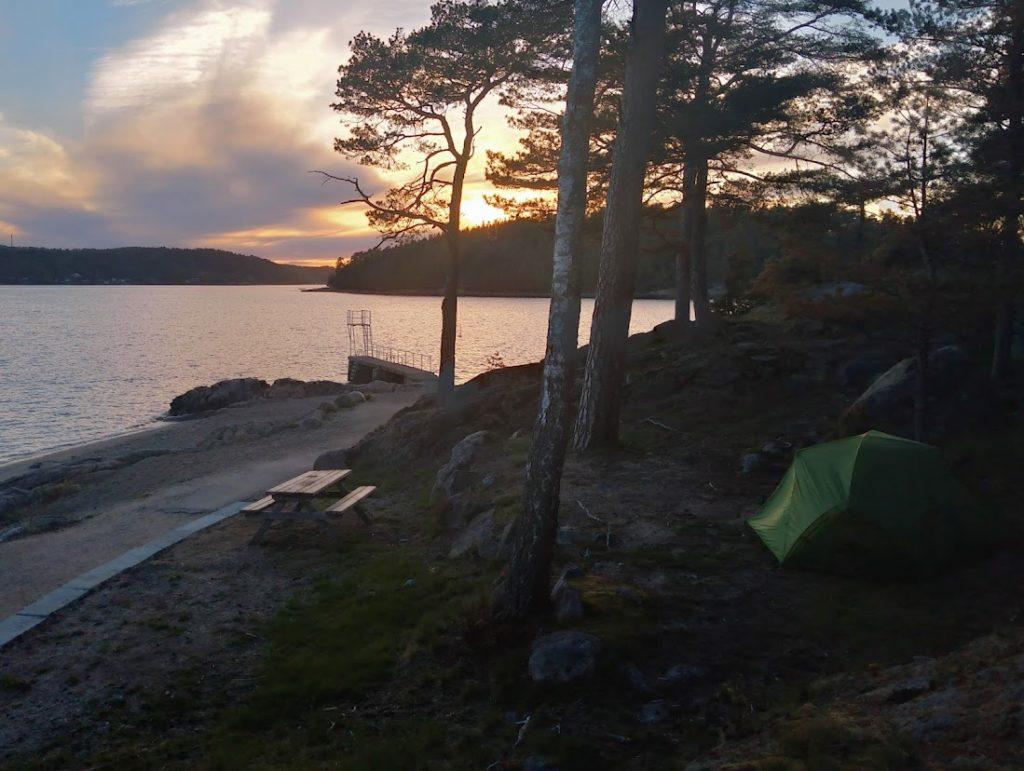
Respect nature and wildlife, take your trash with you, and be quiet. From 15 April to 15 September, open fire in the wild is banned, so forget about campfires in the summer! A total ban on camping stoves is possible during droughts (you can check yr.no for warnings).
In the Norwegian mountains, there are also a lot of open shelters (gapahuk). Most of them are only accessible by mountain bike, but sometimes you will have to walk and push your bike. Some of them have a supply of firewood.
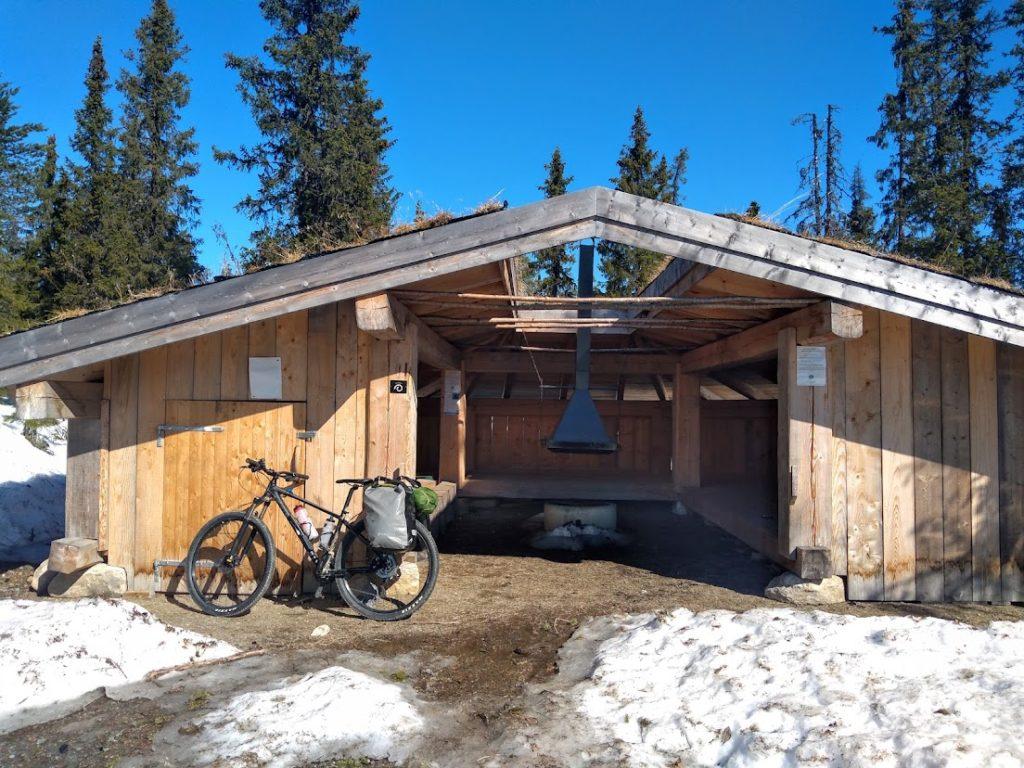
Find the open shelters on this map:
Other accommodation
There are many official campsites in Norway. The price for one person is around 150-300 NOK. Usually, you have to pay extra (10-20 NOK) for the shower.
Hotels and hostels in Norway are expensive. For example, you’ll pay about 40 euros for the cheapest dormitory bed in Bergen. However, in most places, it is even more pricey. You can find a list of cyclist-friendly hotels and B&Bs here.
Money
Currency: Norwegian Krone (NOK).
1 NOK = 0,09 EUR
Norway is one of the most expensive countries in Europe. If you are on a budget, here are some tips to help you survive:
- Don’t buy your food in Joker, Seven-Eleven. Avoid also other convenience stores and kiosks.
- The cheapest supermarkets are Kiwi and Rema 1000. Coop, Rimi and Bunnpris are ok too.
- Look for products labelled as first price – the difference between them and other products is huge!
- Remember that most shops are closed on Sunday (touristy areas are often an exception).
- Forget about alcohol for the time you are staying in Norway. Get drunk back at home. Your wallet will be grateful.
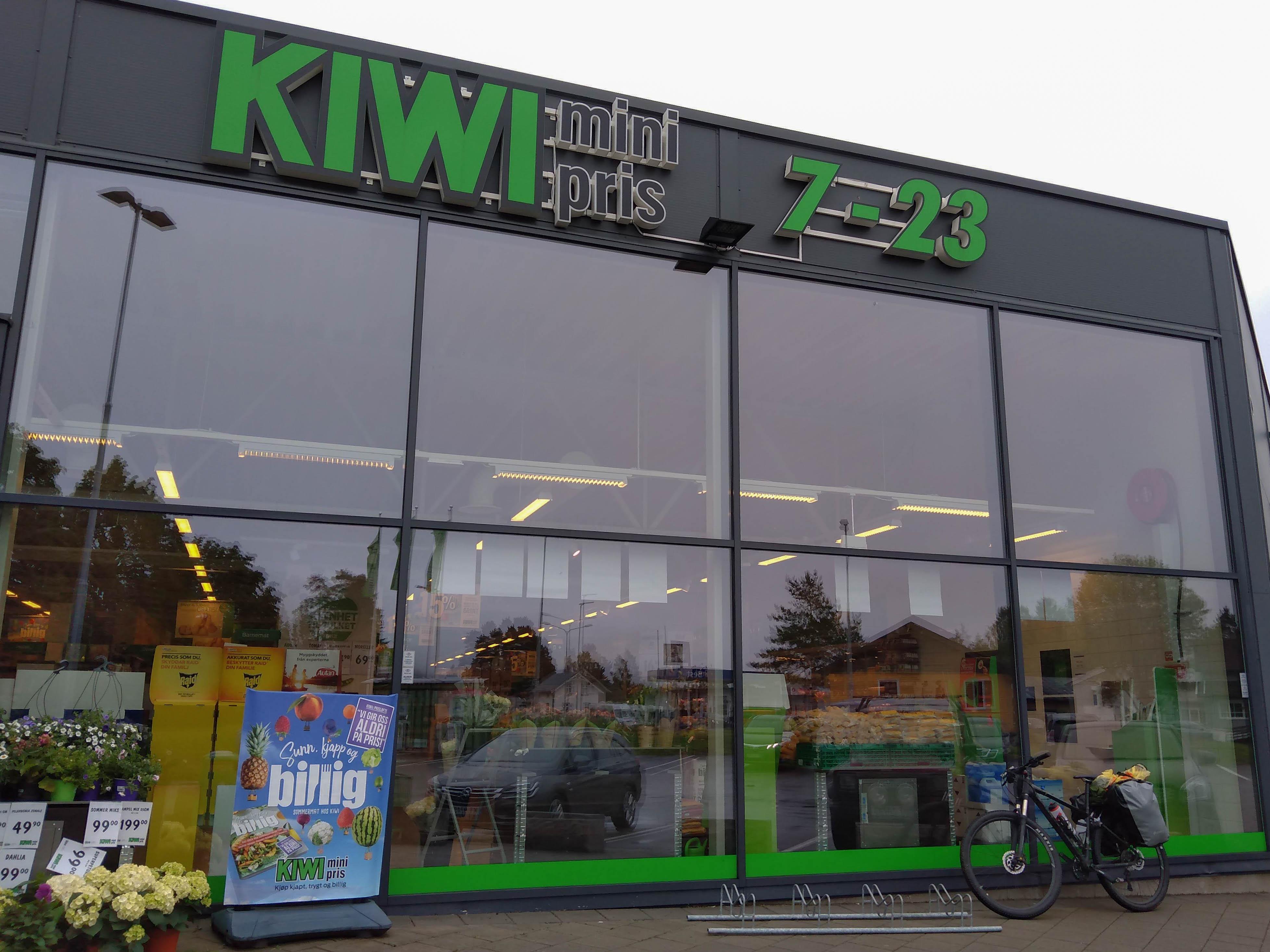
Internet and local SIM card
If you have an EU SIM card, you can relax and stop stressing about bill shock when travelling to Norway. As an EEA member, Norway is part of the roam-like-at-home deal for EU citizens. Depending on your provider, the data package will probably be reduced. However, it should still be sufficient for the basic stuff on 1-2 weeks of cycling holidays in Norway.
If you don’t own an EU SIM card, the best option is to order an e-sim card before your trip. It’s much cheaper than a local prepaid sim card. I recommend getting one from Airalo. For example, an e-sim card with 2 GB data, valid for 15 days costs 7 USD.
The mobile service coverage is generally very good across the whole country. However, in remote mountain areas, you can find yourself without a signal, so make sure you download your maps in case you suddenly go offline.
Cycling in Norway – best routes
You can use ut.no to find exciting bicycle routes in the area you’re visiting (the website is unfortunately only available in Norwegian).
Rallarvegen
The crème de la crème of Norwegian bicycle routes lies on the edge of Hardangervidda, the largest European mountain plateau route, and is a legacy of the Oslo-Bergan railway built at the beginning of the 20th century. Known as the most scenic bicycle trail in Scandinavia, the Rallarvegen was once used to transport the materials and workers building the famous Bergensbanen.
The season to cycle is short, usually from July to mid-September, as the snow lasts long on the elevation between 1000 and 1350 meters. For updates on the current weather conditions on the Rallarvegen, check this Facebook Page.
Route details – Rallarvegen
Length: 82 km
Elevation gain: 560 m
Surface: Gravel, dirt roads
Accommodation: there are several mountain hotels along the route, but the stunning ambience of Hardangervidda just asks you to sleep in a tent. There are good wild camping options along the route, but be aware that it would be difficult around Finse.
Norge på langs – cycling Norway along
This route allows you to cycle the entire length of Norway from south to north – almost 3000 km! It leads from North Cape to Lindesnes through the most beautiful places in the country.
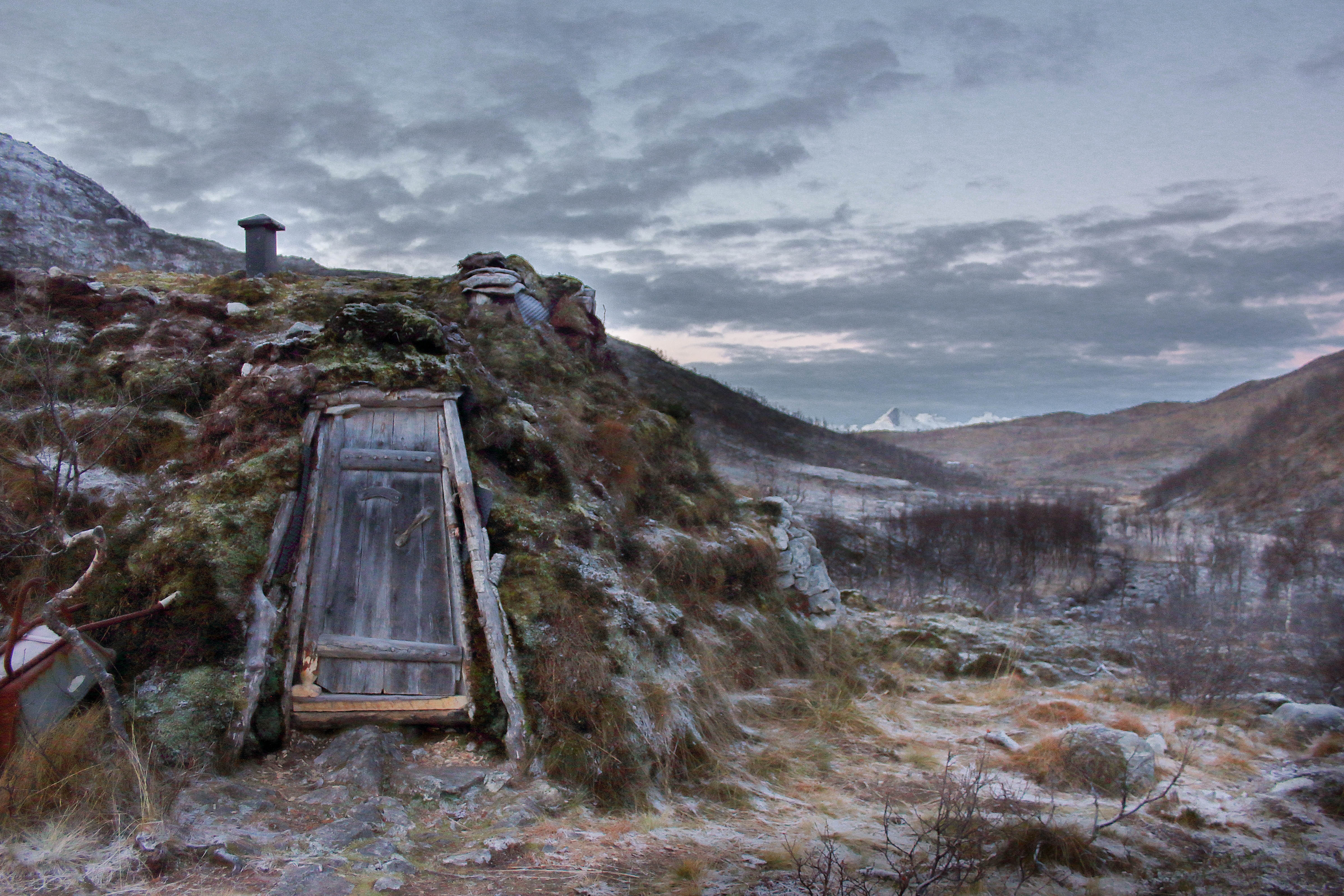
In the North, make sure to stop to get to know the unique culture of the Sami people (Yoik, their unique chant, will give you chills). You can also book a workshop on Sami handcraft and traditional food here.
Then you will cycle through Saltfjellet mountains, with the largest glacier in Northern Scandinavia. In all of Northern Norway, you can expect a nearly empty lonely road surrounded by vast plateaus and raw arctic nature.
But Norway is not only nature. Once you get to Trondheim, you will have a chance for a cultural experience. In the historical capital of Norway, you will find Northern Europe’s most important medieval pilgrimage site – the impressive cathedral Nidarosdommen. Take a slow ride across Bakklandet – a neighbourhood full of cute colourful houses. The steepest street has even a lift for bicycles!
In the region of Møre og Romsdal, you will cycle the most scenic road in Norway – Trollstigen, The Ladder of Trolls. You will also see the most spectacular fjords in the country, including the UNESCO-listed Geirangerfjord, and the tallest vertical rock face in Europe – Trollveggen – Troll Wall.
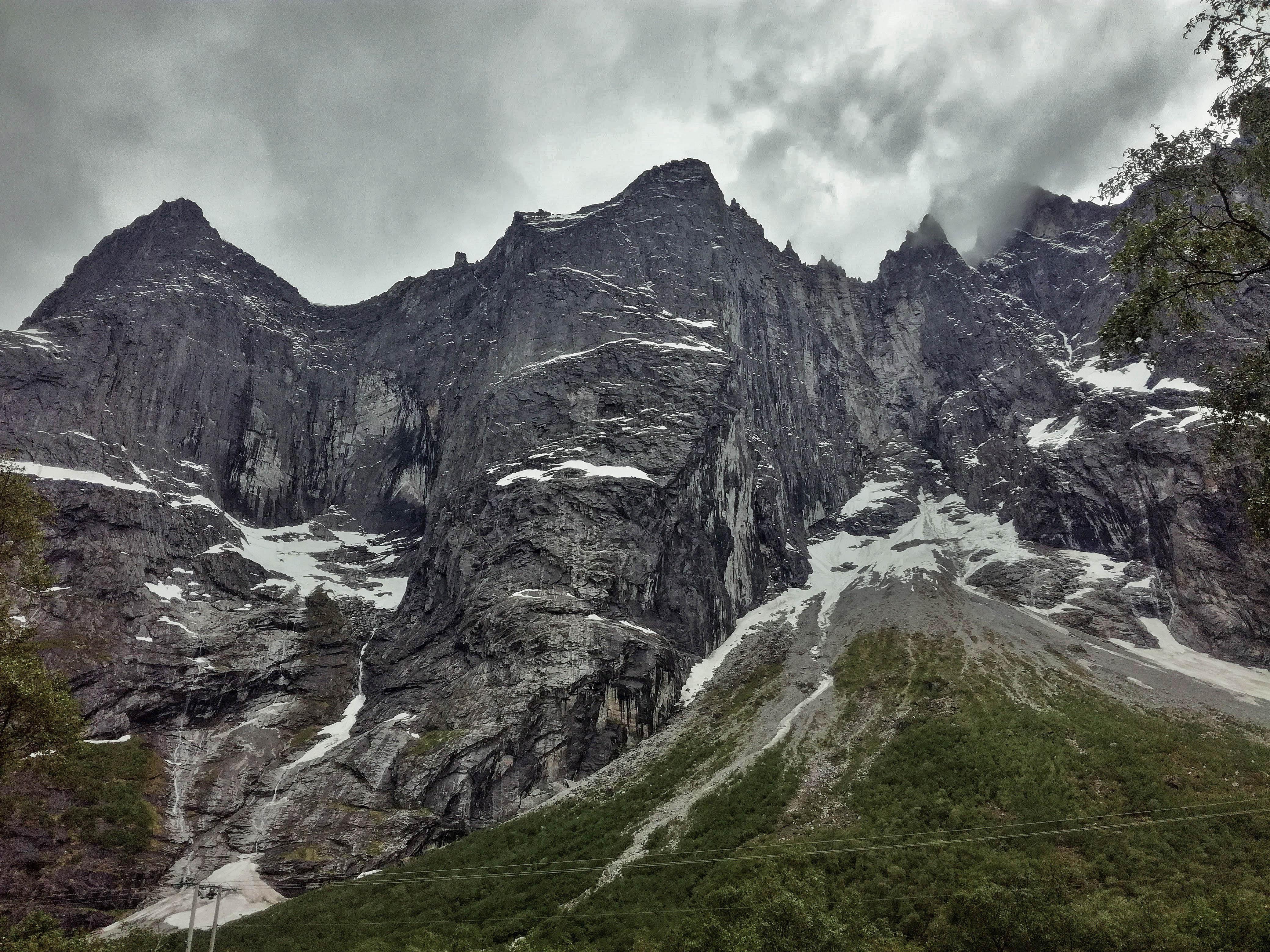
Afterwards, the road will take you more inland, through the highest mountain range in Scandinavia – Jotunheimen. Then you will cycle by the edge of another mountain range – Hallingskarvet, before you arrive in Telemark, the heart of Norway. In Rjukan, take a break, leave your bike and climb Gaustatoppen. On a clear day, you can see almost ⅕ of Norway from the top of this free-standing mountain.
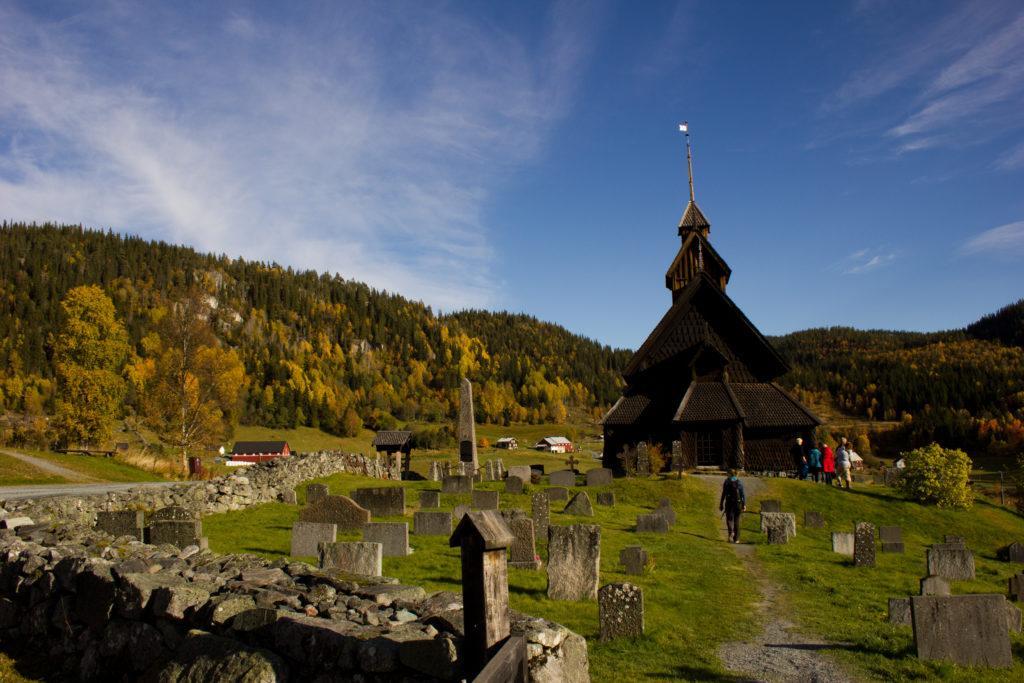
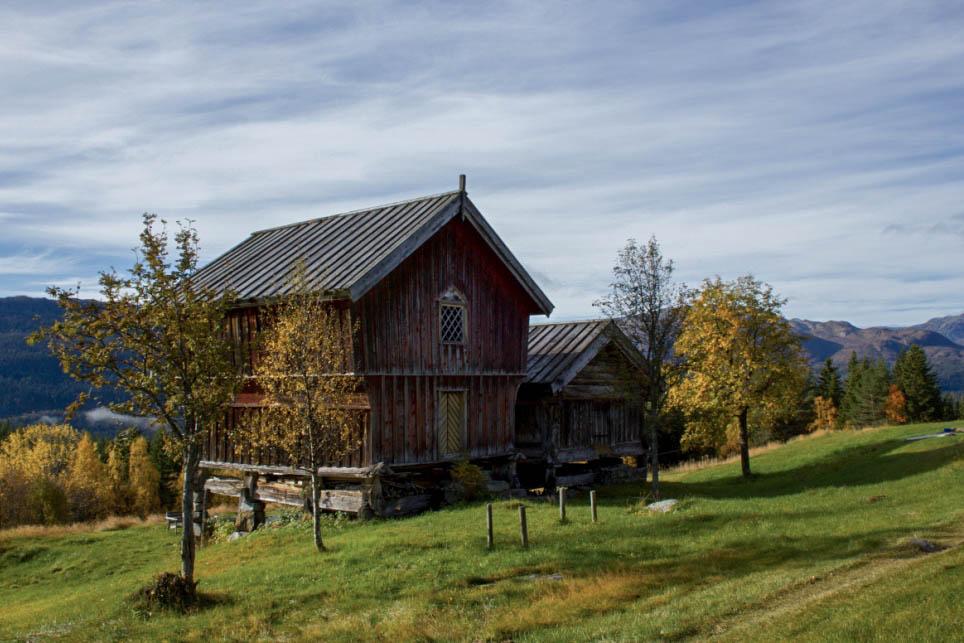
The more south, the less mountainous it gets. The southernmost point of Norway is Lindesnes. Once you get there, first head to the lighthouse and then take a well-deserved rest on a beach!
You can find more information about cycling Norway Along on this website.
Route details – Cycling Norway Along
Length: 2988 km
Elevation gain: 37 835 m
Surface: Mixed, mostly asphalt
Atlantic Coast Route (Eurovelo 1)
If you love the sea, choose the Atlantic Coast Route (Eurovelo 1). A 4500 km route will take you from Svinesund in the south, through Kristiansand, Bergen, Trondheim, North Cape to Kirkenes, in the very northeast, almost by the Russian border.
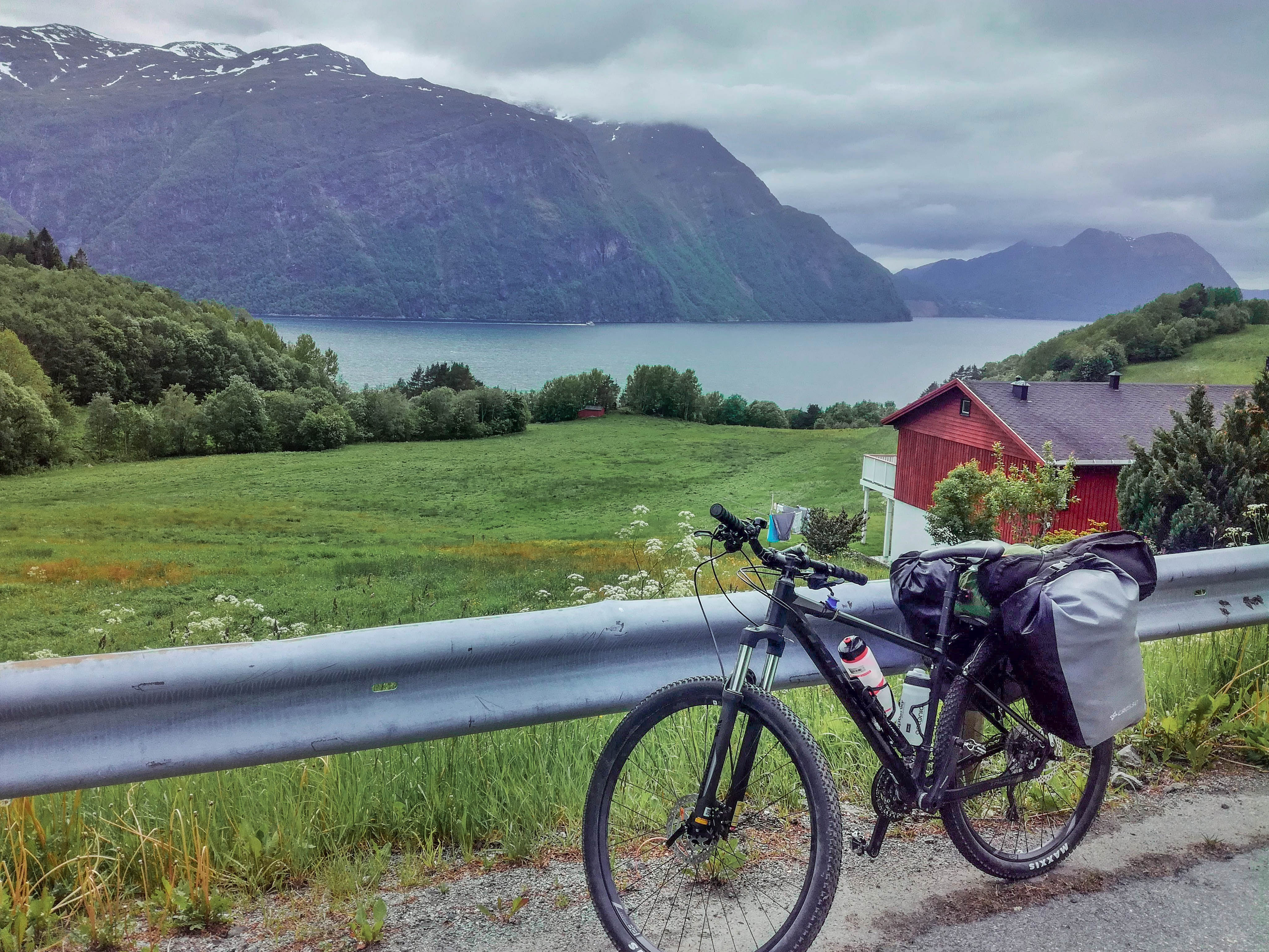
You will have a chance to ride probably the most stunning road in Norway – an 8 km long stretch from Kårvåg to Vevang, with incredible bridges connecting small islands, also known as The Atlantic Road.
You can find the GPS track on Komoot.
Route Details – Eurovelo 1 (Norway)
Length: 3004 km
Elevation gain: 30 090 m
Surface: Mostly asphalt
Tour de Dovre / Lesja and Dovrefjell
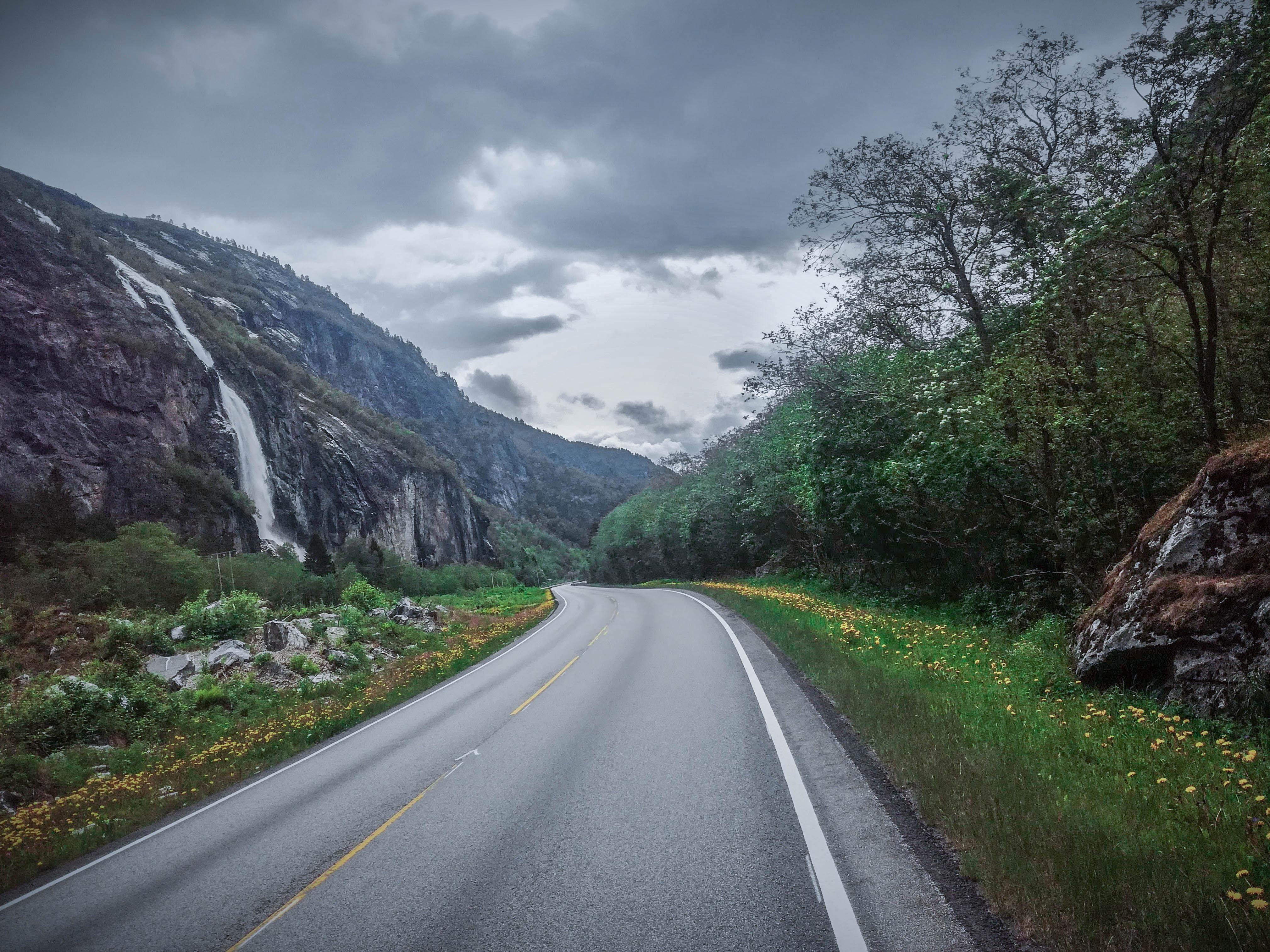
When touring from Ålesund to Fredrikstad in 2019, I was enchanted by the landscape between Åndalsnes and Lejsa. Even though I stuck to the main road, I saw majestic mountains, green pastures, and tall waterfalls. But I wish I made a detour in Dovrefjell and Rondane and followed some of the recommendations from this website.
If you want to immerse yourself in Norwegian nature,Tour de Dovre will be a perfect choice. You will visit three national parks (Rondane, Dovre and Dovrefjell) known for an untouched alpine ecosystem where animals like reindeer and musk ox find their home.
Route Details – Tour de Dovre
Length: 192 km
Elevation gain: 1277 m
Surface: Mixed. Some ashpalt, some gravel roads, some singletracks.
Highlights
You can find a map with my personal highlights in Norway here:
Resources for cycling in Norway
For more inspiration and information about bicycle touring and bikepacking in Norway, check out these links:
- Matthew Norway (Facebook and Youtube) – weekly uploads with the most exciting routes in and practical information about cycling in Norway.
- Tunnels in Norway – I linked it before, but this is so important that I will list it here again so that you can find it easily.
- Ut.no – a Norwegian base of the best hiking and cycling trails, including mountain refuges and shelters.
- Yr.no – the most reliable source for the weather forecast in Norway.
- Statens Vegwesen – updates on traffic information and winter closed roads.
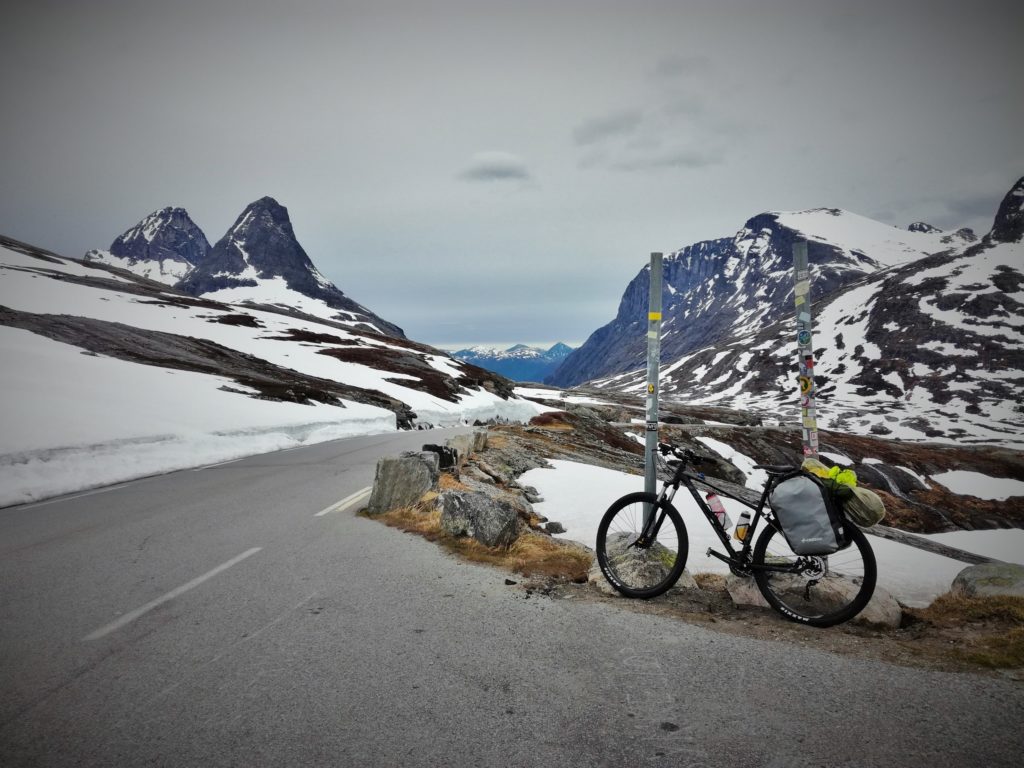
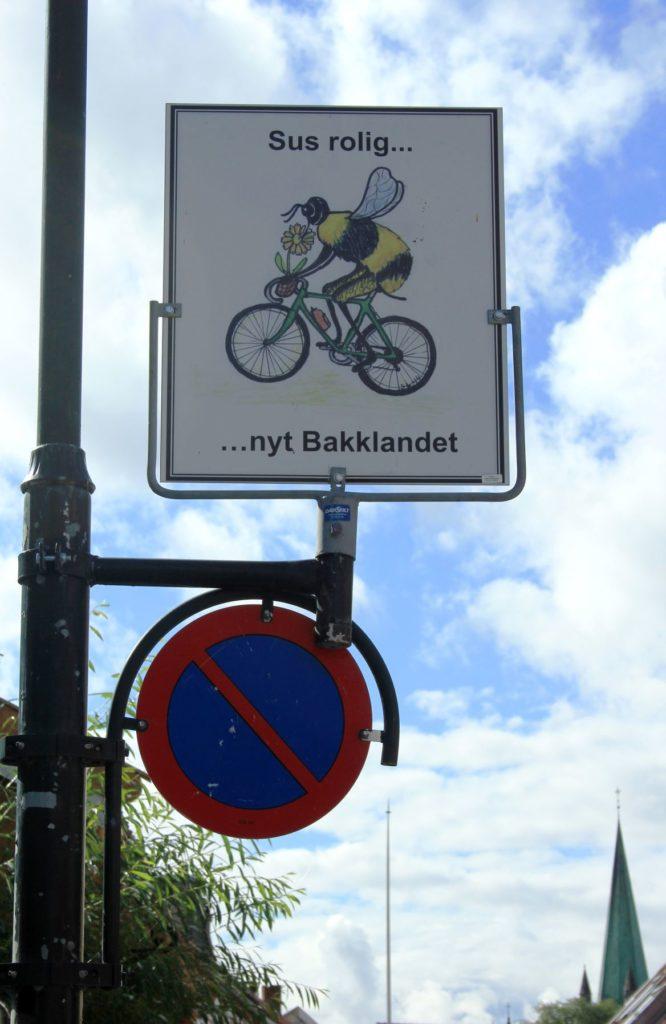
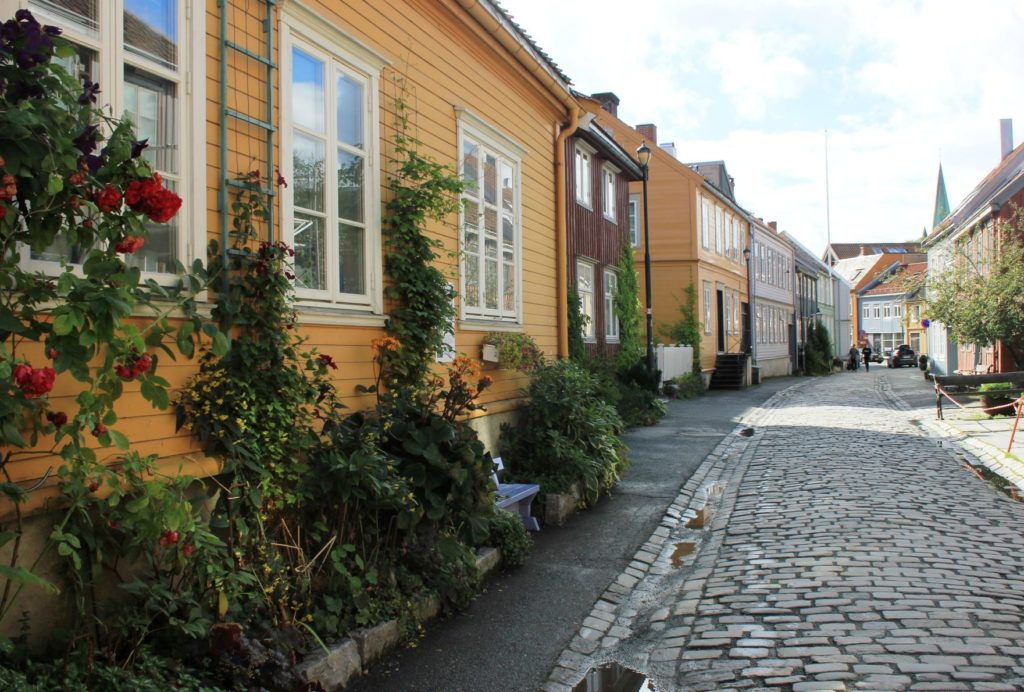
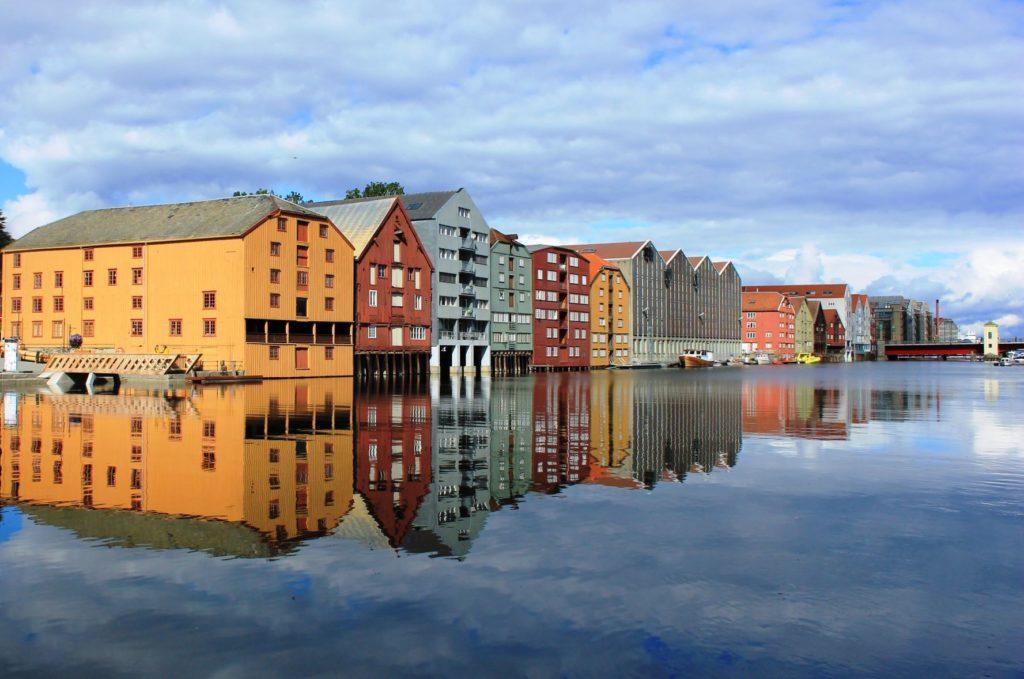
Pingback: Wild camping in Europe - where is it legal and what to do if it's not - Wobbly Ride
Pingback: Best panniers for cycle touring - is Crosso Dry the best low-budget alternative for Ortlieb? - Wobbly Ride
Pingback: Inspiration til cykelture rundt i Europa – Med tog fra Danmark til udlandet
Hi, wanted to say thank you for putting this all together! I’m spending ~4 weeks cycling in Norway this summer, and looking forward to the fun (and hills…and rain!). While I’ve done a number of longer bike trips before, and had done some research on routes / tunnels / etc., I appreciated the wide variety of information you had here–also the fun anecdotes! Ah, who doesn’t love wet socks!
Coincidentally, I also had the Andalsnes area on my route, as well as the Otta-Andalsnes corridor and the climb south past the Trollstigen.
Cheers, and happy cycling,
-Torsti
Oregon, USA
Hi Torsti, thanks for your comment. Norway is amazing, hope you’ll have plenty of fun there! Just keep in mind that Trollstigen was closed last year for safety reasons (too many rockfalls). It is scheduled to be reopened mid-July 2025 but it’s best to check the status online before you embark on your trip. Happy cycling!